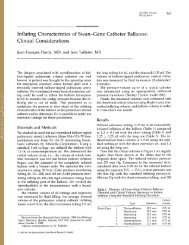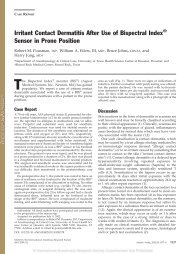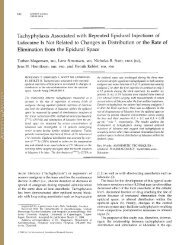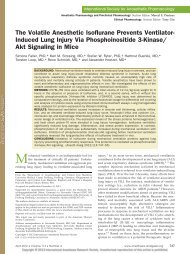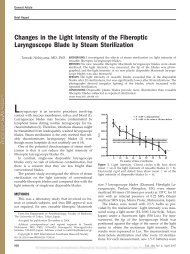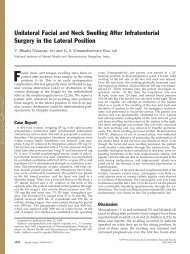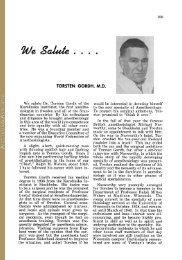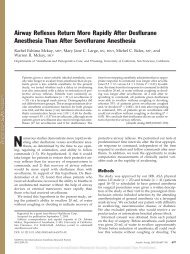A Comparison of Epidural Bupivacaine, Levobupivacaine, and ...
A Comparison of Epidural Bupivacaine, Levobupivacaine, and ...
A Comparison of Epidural Bupivacaine, Levobupivacaine, and ...
Create successful ePaper yourself
Turn your PDF publications into a flip-book with our unique Google optimized e-Paper software.
PEDIATRIC ANESTHESIA SOCIETY FOR PEDIATRIC ANESTHESIA<br />
SECTION EDITOR<br />
WILLIAM J. GREELEY<br />
A <strong>Comparison</strong> <strong>of</strong> <strong>Epidural</strong> <strong>Bupivacaine</strong>, <strong>Levobupivacaine</strong>, <strong>and</strong><br />
Ropivacaine on Postoperative Analgesia <strong>and</strong> Motor Blockade<br />
Pasquale De Negri, MD*, Giorgio Ivani, MD†, Tiziana Tirri, MD*, Pasqualina Modano, MD*,<br />
Cesare Reato, MD*, Staffan Eksborg, PhD‡, <strong>and</strong> Per-Arne Lonnqvist, MD, PhD‡<br />
*Department <strong>of</strong> Anesthesia, ICU <strong>and</strong> Pain Management, Centro di Riferimento Oncologico della Basilicata-Cancer Center,<br />
Rionero in Vulture, Potenza, Italy; †Department <strong>of</strong> Pediatric Anesthesia <strong>and</strong> Intensive Care Unit, “Regina Margherita”<br />
Children’s Hospital, Turin, Italy; <strong>and</strong> ‡Department <strong>of</strong> Women <strong>and</strong> Child Health <strong>and</strong> Department <strong>of</strong> Surgical Sciences,<br />
Karolinska Institute, Stockholm, Sweden<br />
In this prospective, r<strong>and</strong>omized, observer-blinded clinical<br />
trial, we compared the incidence <strong>of</strong> unwanted<br />
lower extremity motor blockade <strong>and</strong> the analgesic efficacy<br />
between small-dose (0.125%; 0.2 mg · kg 1 ·h 1 )<br />
postoperative epidural infusions <strong>of</strong> bupivacaine<br />
(Group B; n 28), levobupivacaine (Group L; n 27),<br />
<strong>and</strong> ropivacaine (Group R; n 26) in children after hypospadias<br />
repair. Motor blockade <strong>and</strong> pain were assessed<br />
at predetermined time points during 48 h by using<br />
a modified Bromage scale <strong>and</strong> the Children’s <strong>and</strong><br />
Infant’s Postoperative Pain Scale (CHIPPS). Postoperative<br />
analgesia was almost identical in all three study<br />
groups (CHIPPS range, 0–3), with no need for the<br />
<strong>Bupivacaine</strong> has, until recently, been the drug <strong>of</strong><br />
choice for postoperative epidural infusions in<br />
children. Despite a reasonable safety pr<strong>of</strong>ile, bupivacaine<br />
is currently being replaced by many anesthesiologists<br />
with new local anesthetics: levobupivacaine<br />
<strong>and</strong> ropivacaine. These local anesthetics are<br />
associated with less risk for cardiac <strong>and</strong> central nervous<br />
system toxicity <strong>and</strong> are also less likely to result in<br />
unwanted postoperative motor blockade (1,2). Despite<br />
numerous publications with regard to the use <strong>of</strong><br />
levobupivacaine <strong>and</strong> ropivacaine in children, no r<strong>and</strong>omized<br />
studies have compared the use <strong>of</strong> these three<br />
drugs for continuous postoperative epidural infusion.<br />
Thus, the aim <strong>of</strong> this investigation was to compare the<br />
effect <strong>of</strong> a continuous postoperative epidural infusion<br />
<strong>of</strong> these three local anesthetic drugs on motor blockade<br />
<strong>and</strong> pain relief after hypospadias repair.<br />
Accepted for publication January 16, 2004.<br />
Address correspondence to Pasquale De Negri, MD, Department<br />
<strong>of</strong> Anesthesia, ICU <strong>and</strong> Pain Management, CROB-Cancer Center,<br />
Strada Provinciale del Vulture 8, Rionero in Vulture (PZ), 85028,<br />
Italy. Address e-mail to pdenegri@crob.it. Reprints will not be available<br />
from the authors.<br />
DOI: 10.1213/01.ANE.0000120162.42025.D0<br />
administration <strong>of</strong> supplemental analgesia in any patient.<br />
However, significantly more patients in Group B<br />
(n 6; P 0.03) displayed signs <strong>of</strong> unwanted motor<br />
blockade during the observation period compared with<br />
Group L (n 0) <strong>and</strong> Group R (n 0). In conclusion,<br />
significantly less unwanted motor blockade was associated<br />
with postoperative epidural infusions <strong>of</strong> 0.125%<br />
levobupivacaine or ropivacaine in children after hypospadias<br />
repair as compared with a similar infusion <strong>of</strong><br />
bupivacaine. However, no difference with regard to<br />
postoperative analgesia could be detected among the<br />
three different local anesthetics studied.<br />
(Anesth Analg 2004;99:45–8)<br />
Methods<br />
After IRB approval <strong>and</strong> written, informed parental consent,<br />
90 boys (2–6 yr <strong>of</strong> age; ASA status I) scheduled for<br />
hypospadias repair were included in this prospective,<br />
r<strong>and</strong>omized study. All patients received oral premedication<br />
with midazolam 0.5 mg/kg approximately 45 min<br />
before arrival in the operating room. After st<strong>and</strong>ard noninvasive<br />
monitoring was applied, general anesthesia was<br />
induced with sev<strong>of</strong>lurane 8% by face mask. After the<br />
induction <strong>of</strong> anesthesia, the airway was managed either<br />
by a laryngeal mask airway or by endotracheal intubation<br />
(facilitated by atracurium 0.5 mg/kg). Anesthesia<br />
was thereafter maintained with is<strong>of</strong>lurane 0.8%–1% in an<br />
oxygen/air mixture throughout the remaining part <strong>of</strong><br />
the procedure.<br />
With the patient in the lateral decubitus position, an<br />
epidural catheter (Portex 19-gauge epidural kit) was<br />
placed at the L5-S1 level by using a loss-<strong>of</strong>-resistance<br />
technique. The catheter was threaded approximately 3<br />
cm in the caudal direction. After placement <strong>of</strong> the<br />
epidural catheter, all patients received incremental injections<br />
<strong>of</strong> 0.2% ropivacaine up to a total dose <strong>of</strong><br />
1.4 mg/kg while they were watched for signs <strong>of</strong> toxicity<br />
(no epinephrine-containing test dose was used).<br />
©2004 by the International Anesthesia Research Society<br />
0003-2999/04 Anesth Analg 2004;99:45–8 45
46 PEDIATRIC ANESTHESIA DE NEGRI ET AL. ANESTH ANALG<br />
EPIDURAL LOCAL ANESTHESIA INFUSIONS IN CHILDREN 2004;99:45–8<br />
The maximum volume <strong>of</strong> ropivacaine was 20 mL. The<br />
patient was then prepared, <strong>and</strong> surgery was allowed<br />
to commence. The block was judged as successful if<br />
there was no or a only minor (15% increase) hemodynamic<br />
reaction (heart rate, noninvasive arterial<br />
blood pressure, or both) to the start <strong>of</strong> surgery. Sixty<br />
minutes after the initial epidural injection, a continuous<br />
infusion <strong>of</strong> plain ropivacaine 0.125% was started<br />
at a rate <strong>of</strong> 0.2 mg · kg 1 · h 1 <strong>and</strong> was continued for<br />
the duration <strong>of</strong> the surgical procedure.<br />
After emergence from the anesthetic, patients were<br />
transferred to the recovery area. Immediately after arrival<br />
to the recovery room, patients received, according<br />
to the previous r<strong>and</strong>omization, 1 <strong>of</strong> 3 different epidural<br />
infusions—levobupivacaine 0.125% 0.2 mg · kg 1 · h 1<br />
(group L), ropivacaine 0.125% 0.2 mg · kg 1 · h 1 (group<br />
R), or bupivacaine 0.125% 0.2 mg · kg 1 · h 1 (group<br />
B)—for 48 h. The infusions were prepared, given a code<br />
number, <strong>and</strong> connected to the patient by an operator<br />
who took no further part in the study.<br />
Postoperative analgesia (Fig. 1) <strong>and</strong> the degree <strong>of</strong> motor<br />
blockade were assessed every 4 h throughout the first<br />
48 postoperative hours. Analgesia was assessed by using<br />
the Children’s <strong>and</strong> Infant’s Postoperative Pain Scale<br />
(CHIPPS) (3), <strong>and</strong> the degree <strong>of</strong> motor blockade was<br />
recorded by using a modified Bromage scale (4). Trained<br />
nurses unaware <strong>of</strong> the r<strong>and</strong>omization performed all the<br />
postoperative assessments.<br />
Patients were not prescribed any postoperative analgesics<br />
apart from the epidural infusion. Rescue analgesia<br />
with acetaminophen-codeine suppositories<br />
(200 mg/5 mg) was administered according to patient<br />
weight if the CHIPPS score was 4. The time to first<br />
need for rescue analgesia <strong>and</strong> the total amount <strong>of</strong><br />
supplemental analgesics were also recorded during<br />
the 48-h observation period.<br />
Statistical analysis was performed by nonparametric<br />
tests as appropriate, <strong>and</strong> P values 0.05 were considered<br />
significant. On the basis <strong>of</strong> pilot data, the<br />
study was designed to be able to detect a 15% difference<br />
between study groups with regard to the number<br />
<strong>of</strong> patients with an absence (score 0) or presence (score<br />
1–3) <strong>of</strong> motor blockade during the postoperative period.<br />
A power calculation based on these assumptions<br />
together with an <strong>of</strong> 0.05 <strong>and</strong> a <strong>of</strong> 0.8 resulted in the<br />
need for 25 patients in each treatment group.<br />
Results<br />
A total <strong>of</strong> 90 patients were included in the study. Two<br />
patients in group B, three patients in group L, <strong>and</strong> four<br />
patients in group R were excluded from the analysis<br />
because <strong>of</strong> an inadequate block or modification <strong>of</strong> the<br />
planned surgery after inclusion in the study. Thus, the<br />
final number <strong>of</strong> patients in each group was 28, 27, <strong>and</strong><br />
26 for groups B, L, <strong>and</strong> R, respectively. Patient demographics<br />
<strong>and</strong> other basic data are displayed in Table 1.<br />
Figure 1. Mean CHIPPS scores for the first 48 postoperative hours.<br />
A CHIPPS score exceeding 3 indicated a need for supplemental<br />
rescue analgesia. Levo levobupivacaine; bupi bupivacaine; ropi<br />
ropivacaine.<br />
None <strong>of</strong> the patients displayed any signs <strong>of</strong> motor<br />
blockade during the first 12 h <strong>of</strong> infusion. Only patients<br />
in group B displayed signs <strong>of</strong> motor blockade<br />
during the 12- to 48-h postoperative period. Thus, 6<br />
patients in group B had motor block scores <strong>of</strong> 1 or<br />
2 during the postoperative period, a finding that was<br />
significantly higher compared with both group L (P <br />
0.03) <strong>and</strong> group R (P 0.03). None <strong>of</strong> the patients had<br />
a motor block score <strong>of</strong> 3. If expressed as 95% confidence<br />
intervals for the occurrence <strong>of</strong> unwanted postoperative<br />
motor block (percentage <strong>of</strong> patients) these<br />
95% confidence intervals were 0%–10%, 0%–11%, <strong>and</strong><br />
8%–41% for groups L, R, <strong>and</strong> B, respectively.<br />
No significant difference among groups could be<br />
observed at any <strong>of</strong> the observation points during the 0to<br />
48-h postoperative period with regard to CHIPPS<br />
score (Fig. 1). Because none <strong>of</strong> the patients had a<br />
CHIPPS score <strong>of</strong> 4, no supplemental analgesia was<br />
administered in any <strong>of</strong> the study groups. No other<br />
side effects were noted in any patient during the study<br />
period.<br />
Discussion<br />
The main finding <strong>of</strong> this study was that epidural infusions<br />
<strong>of</strong> 0.125% solutions <strong>of</strong> bupivacaine, levobupivacaine,<br />
or ropivacaine resulted in almost identical<br />
postoperative analgesia after hypospadias repair in<br />
children. No signs <strong>of</strong> postoperative motor blockade<br />
were observed in patients given levobupivacaine or<br />
ropivacaine, whereas bupivacaine caused minor to<br />
moderate postoperative motor block in approximately<br />
20% <strong>of</strong> the patients.<br />
The primary aim <strong>of</strong> this study was to evaluate<br />
whether postoperative epidural infusions <strong>of</strong> the studied<br />
local anesthetics were associated with the occurrence<br />
<strong>of</strong> unwanted motor blockade. To allow this, we<br />
had to avoid a situation in which the intraoperative
ANESTH ANALG PEDIATRIC ANESTHESIA DE NEGRI ET AL. 47<br />
2004;99:45–8 EPIDURAL LOCAL ANESTHESIA INFUSIONS IN CHILDREN<br />
Table 1. Patient Data<br />
Variable<br />
activation <strong>of</strong> the epidural blockade by a bolus injection<br />
<strong>of</strong> local anesthetics would confound the baseline situation<br />
after surgery. A different design might have<br />
caused a situation in which some patients had unwanted<br />
motor blockade immediately after surgery.<br />
Because caudal bolus injection <strong>of</strong> 0.2% ropivacaine in<br />
children has not been associated with motor blockade<br />
(4–6), <strong>and</strong> because ropivacaine (based on minimal<br />
local anesthetic concentrations [MLAC] studies) is regarded<br />
as less potent than bupivacaine (7,8), we decided<br />
to activate the epidural blockade during surgery<br />
with 0.2% ropivacaine in all patients. The observation<br />
that all patients had a motor block score <strong>of</strong> 0 in the<br />
recovery room verifies that this study design achieved<br />
the objective <strong>of</strong> producing a baseline situation with no<br />
signs <strong>of</strong> unwanted motor blockade in any patient.<br />
Our finding <strong>of</strong> a significantly more frequent incidence<br />
<strong>of</strong> motor blockade with the use <strong>of</strong> 0.125% bupivacaine<br />
infusion versus similar concentrations <strong>of</strong> levobupivacaine<br />
or ropivacaine is in keeping with previous reports<br />
<strong>of</strong> a better discrepancy between analgesia <strong>and</strong> motor<br />
blockade for the new long-acting local anesthetics in<br />
adults (1,2). The present finding is also similar to our<br />
previously reported data after single-injection caudal<br />
blockade in children, where the use <strong>of</strong> 0.25% bupivacaine<br />
caused a more frequent incidence <strong>of</strong> motor blockade<br />
compared with 0.25% levobupivacaine or 0.2%<br />
ropivacaine (4). This difference between bupivacaine<br />
on one h<strong>and</strong> <strong>and</strong> levobupivacaine <strong>and</strong> ropivacaine on<br />
the other was still present in the current study despite<br />
the use <strong>of</strong> more dilute local anesthetic solutions for<br />
continuous epidural infusion.<br />
The incidence <strong>of</strong> unwanted motor blockade associated<br />
with the use <strong>of</strong> bupivacaine could most likely be<br />
eliminated if even smaller concentrations were used,<br />
but a previous study by Wolf et al. (9) showed that<br />
such dilute bupivacaine solutions are associated with<br />
an unreliable analgesic effect. Thus, either <strong>of</strong> the two<br />
new long-acting local anesthetics should be used for<br />
postoperative epidural infusion instead <strong>of</strong> bupivacaine<br />
to minimize the risk for unwanted postoperative<br />
motor blockade in children.<br />
In keeping with previous pediatric studies (4–6,10–<br />
12), we were unable to identify any difference with<br />
regard to postoperative analgesia among the three<br />
different local anesthetics used, despite using only<br />
0.125% concentrations <strong>of</strong> each drug. This observation<br />
was true concerning both CHIPPS scores <strong>and</strong> the need<br />
for supplemental postoperative analgesia. Thus, from<br />
a clinical perspective, the 0.125% concentration <strong>of</strong> the<br />
3 studied local anesthetics appears equipotent with<br />
regard to postoperative analgesia after epidural infusion<br />
in children.<br />
As noted above, ropivacaine has been claimed to<br />
possess only 60% <strong>of</strong> the analgesic potency <strong>of</strong> bupivacaine<br />
on the basis <strong>of</strong> findings generated in MLAC<br />
studies (7,8). However, the generalization <strong>of</strong> potency<br />
data from MLAC studies has been questioned because<br />
<strong>of</strong> the specific circumstances associated with obstetric<br />
epidural analgesia <strong>and</strong> because <strong>of</strong> the scientific design<br />
<strong>of</strong> MLAC studies.<br />
In summary, significantly less unwanted motor<br />
blockade was associated with postoperative epidural<br />
infusions <strong>of</strong> 0.125% levobupivacaine or ropivacaine in<br />
children after hypospadias repair as compared with a<br />
similar infusion <strong>of</strong> bupivacaine. No difference with<br />
regard to postoperative analgesia could be detected<br />
among the three different local anesthetics studied.<br />
References<br />
Group<br />
<strong>Levobupivacaine</strong> Ropivacaine <strong>Bupivacaine</strong><br />
No. Patients 27 26 28<br />
ASA physical status I I I<br />
Age (mo) 29 10 30 8 27 16<br />
Weight (kg) 14 6 15 4 14 7<br />
Preoperative heart rate (bpm) 103 11 107 4 106 9<br />
Preoperative systolic NIBP (mm Hg) 85 5 82 7 83 6<br />
Postoperative heart rate (bpm), 0–24 h 105 7 104 6 108 7<br />
Postoperative systolic NIBP (mm Hg), 0–24 h 90 7 92 8 87 6<br />
NIBP noninvasive blood pressure.<br />
Data are displayed as mean sd.<br />
1. McClure JH. Ropivacaine. Br J Anaesth 1996;76:300–7.<br />
2. Foster RH, Markham A. <strong>Levobupivacaine</strong>: a review <strong>of</strong> its pharmacology<br />
<strong>and</strong> use as a local anaesthetic. Drugs 2000;59:551–79.<br />
3. Buttner W, Finke W. Analysis <strong>of</strong> behavioural <strong>and</strong> physiological<br />
parameters for the assessment <strong>of</strong> postoperative analgesic dem<strong>and</strong><br />
in newborns, infants <strong>and</strong> young children: a comprehensive<br />
report on seven consecutive studies. Paediatr Anaesth 2000;<br />
10:303–18.<br />
4. Ivani G, De Negri P, Conio A, et al. <strong>Comparison</strong> <strong>of</strong> racemic<br />
bupivacaine, ropivacaine <strong>and</strong> levobupivacaine for paediatric<br />
caudal anaesthesia: effects on postoperative analgesia <strong>and</strong> motor<br />
blockade. Reg Anesth Pain Med 2002;27:157–61.<br />
5. Ivani G, Lampugnani E, Torre M, et al. <strong>Comparison</strong> <strong>of</strong> ropivacaine<br />
with bupivacaine for paediatric caudal block. Br J Anaesth<br />
1998;81:247–8.
48 PEDIATRIC ANESTHESIA DE NEGRI ET AL. ANESTH ANALG<br />
EPIDURAL LOCAL ANESTHESIA INFUSIONS IN CHILDREN 2004;99:45–8<br />
6. Ivani G, Lampugnani E, De Negri P, et al. Ropivacaine vs bupivacaine<br />
in major surgery in infants. Can J Anaesth 1999;46:467–9.<br />
7. Polley LS, Columb MO, Naughton NN, et al. Relative potencies<br />
<strong>of</strong> ropivacaine <strong>and</strong> bupivacaine for epidural analgesia in labour.<br />
Anesthesiology 1999;90:944–50.<br />
8. D’Angelo R, James RL. Is ropivacaine less potent than bupivacaine?<br />
Anesthesiology 1999;90:941–3.<br />
9. Wolf AR, Valley RD, Fear DW, et al. <strong>Bupivacaine</strong> for caudal<br />
analgesia in infants <strong>and</strong> children: the optimal effective concentration.<br />
Anesthesiology 1988;69:102–6.<br />
10. Koinig H, Krenn CG, Glaser C, et al. The dose-response <strong>of</strong><br />
caudal ropivacaine in children. Anesthesiology 1999;90:<br />
1339–44.<br />
11. Khalil S, Campos C, Farag AM, et al. Caudal block in children:<br />
ropivacaine compared with bupivacaine. Anesthesiology 1999;<br />
91:1279–84.<br />
12. Taylor R, Eyres R, Chalkiadis GA, Austin S. Efficacy <strong>and</strong> safety<br />
<strong>of</strong> caudal injection <strong>of</strong> levobupivacaine, 0.25%, in children under<br />
2 years <strong>of</strong> age undergoing inguinal hernia repair, circumcision<br />
or orchidopexy. Paediatr Anaesth 2003;13:114–21.





